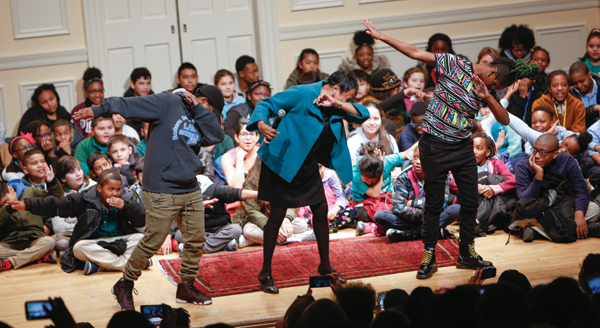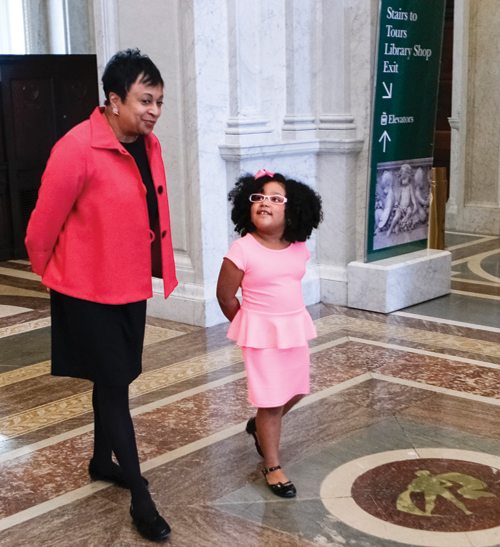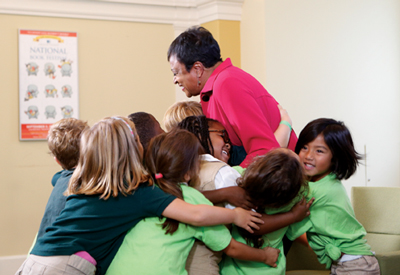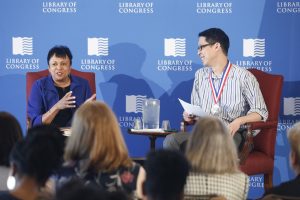Carla Hayden's Big Plans for Kids at the Library of Congress
Children and teens play an active role at the world's largest library under Carla Hayden. A Q&A with the nation's 14th Librarian of Congress.

Librarian of Congress Carla Hayden (center) with local students. All photos by Shawn Miller
Carla Hayden, the 14th U.S. Librarian of Congress, has a lot of plans for kids. We spoke with her about the Young Readers Center, a space for children and teens at the Library of Congress, where Hayden has hosted authors including Gene Luen Yang, Cokie Roberts, and Rep. John Lewis; plus her goals for digitization, a maker space, and more. During your ALA presidency (2003–4), your theme was “equity of access.” Equity and children’s services have been ongoing priorities for you throughout your career. How are those coming to the fore in your current position? I’m very fortunate that I get a chance at the Library of Congress to bring those ideas together, making sure that as many people as possible have access to the Library of Congress—the world’s largest library—with its many unique and wonderful items. And to make sure that there’s an emphasis on young people and giving them the information and background and helping them make history. You have so many ideas about expanding access to the collection for children, both at the Young Readers Center, located at the Library, and throughout the country by increasing use of the digital collection. One of the first things that we’re doing in terms of increasing access at the Young Readers Center is opening it up—more hours. We just opened on Saturdays and also when we have authors—and there’s going to be an author today!—to livestream the presentation out to communities in the country. And we started with public libraries. We’re hoping to expand it to school libraries, other places that young people gather. And, of course, using the tools of the day, technology, to give access wherever young people, and anyone, would be, to digitize collections, some of our unique items will be digitized. Quite a few of them already are. I hear there’s more than 160 million items in the collection, and 10,000 more coming in every day. It’s quite something! But think of having that at your fingertips.
Hosting “Librarian for the Day” Daliyah
Marie Arana, age four.

Greeting kids at the YRC.
Public libraries and school libraries have always been havens for families and children. You know this first hand from your time as director of the Enoch Pratt Free Library in Baltimore, when you kept the library open following the death of Freddie Gray in 2015. How can librarians preserve equity of access today? This is a wonderful time for librarians in all settings to maintain what the basic mission of a library is, and that is to provide the most accurate information [and] to provide sanctuary and safety for people as they pursue their own ideas. And so we are, I think, in a continuing aspect of being that place, that safe place, in communities, in schools—wherever we are. The library should be that neutral zone. “Fake news” is a topic that is top of mind for so many librarians teaching information literacy right now. How can the Library of Congress play a role in K–12 information literacy? All libraries have an opportunity. And the Library of Congress is, of course, an authoritative source for information. Making sure that the networks of libraries are vital and that we all cooperate and partner will strengthen local efforts, [as will] really looking at the school library effort with information literacy. That’s the first library experience for many young people. That’s where they learn to use a library—it’s their school library. So we’ll be hoping that our Teaching with Primary Sources, that expansion, will help our school library effort. How young should kids be when they start learning information literacy and news literacy? I have a healthy respect for the intellect of young people. I just spent time with an eight- and a seven-year-old who were very interested in how to take in information, and they have so many choices now. So, as early as possible—three, four years old there might be ways to talk about what you see, what you might think. I don’t think you can start early enough.
Hayden and National Ambassador for Young People's Literature Gene Luen Yang discuss Yang's "Reading Without Walls" project.
If kids could see, say, five top items in the Library of Congress collection, what would you suggest? There are several things that would interest young people, depending on their age. Of course, the Gutenberg Bible. It’s big, you get to talk about books, and that would be something that I think that young people would be interested in. America’s birth certificate, the first time the word “America” appears in English, would be something that we could relate to them. Thomas Jefferson’s library—all of the books that he had, and why those books are part of the Library of Congress. If they’re very fortunate in terms of a tour, they hear about Abraham Lincoln, and there’s a life mask of Abraham Lincoln. That’s actually online now, and you could look at that. And then of course, Rosa Parks’s handwritten notes about how she felt when she was arrested. I think that would really resonate with young people today. Does the Library of Congress have a role in STEM education and library maker spaces? Of course! And I hope people don’t think I put you up to that. But that’s part of what we’re hoping the expansion of the Young Readers Center will include: a maker space and more opportunities for young people to create their own history and to do things right there on the spot. So you will be seeing a maker space activity area at the Library of Congress. You also have a teen board of book reviewers at the Young Readers Center, and you have plans for more. Yes, and we want to expand. In fact, I met with them recently to say, “You are our primary source—our own primary source—of thinking about how the space could be reconfigured. What would make it easier for you? What would you like to see? Right now, you get a reader’s card for using the library at 16. What are some spaces that might help you if you were 12 or 13?” We’re putting everybody to work!RELATED
RECOMMENDED
CAREERS
The job outlook in 2030: Librarians will be in demand
CAREERS
The job outlook in 2030: Librarians will be in demand
ALREADY A SUBSCRIBER? LOG IN
We are currently offering this content for free. Sign up now to activate your personal profile, where you can save articles for future viewing






Add Comment :-
Comment Policy:
Comment should not be empty !!!
todd Burleson
Dr. Hayden is hands down one of the finest people I have ever had the honor to meet. She is bringing the LOC into the 21st century by focusing efforts on educators and the students of today. I'm incredibly excited by the direction she is steering the LOC. Thank you for this outstanding interview!Posted : Jul 01, 2017 10:01
Laura Jimenez
This is a great write up of Dr. Hayden and her work with authors and children on behalf of the library of congress. She is an excellent resource and champion for the library system. I would respectfully ask that you correct the title and the first sentence of the article. Dr. Hayden earned a Ph.D. from the Graduate Library School of the University of Chicago. By not addressing her as Dr. Hayden the article removes some of her professional standing.Posted : May 09, 2017 01:37